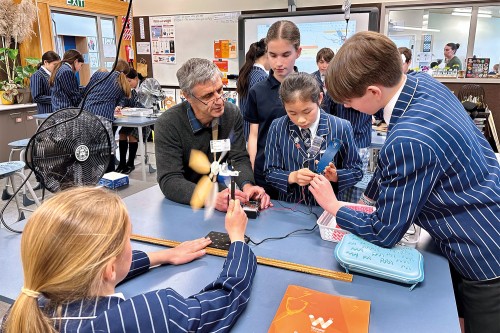
You are logged in as
Logout
You are logged in as
Logout
Regulus // Issue 3 // November 2023
 In Term 3, all Year 7 classes, and two Year 8 classes took part in the dynamic and competitive Power Challenge, which taught them about the wonderful world of electricity, says teacher, Christina Fitzgerald, who runs the Practical Science programme in the Preparatory School. “The students really enjoyed the programme. It is part of Engineering New Zealand’s Wonder Project, which aims to spark wonder in students from Years 5–13 and get them excited about a future career path in STEM, which has a current skills shortage across the country.”
In Term 3, all Year 7 classes, and two Year 8 classes took part in the dynamic and competitive Power Challenge, which taught them about the wonderful world of electricity, says teacher, Christina Fitzgerald, who runs the Practical Science programme in the Preparatory School. “The students really enjoyed the programme. It is part of Engineering New Zealand’s Wonder Project, which aims to spark wonder in students from Years 5–13 and get them excited about a future career path in STEM, which has a current skills shortage across the country.”
During the six-week Power Challenge, the students learnt about electricity, how it is generated, moved, and used across Aotearoa. Their task was to design and build a wind turbine and use the electricity it generated to light up a mini town, which featured on an LED board.
One of the unique aspects of the programme is that Engineering New Zealand partners with STEM professionals to visit schools and work directly with teachers and the students to grow their skills and confidence. “We had six incredible and inspiring local engineers work with our budding STEM enthusiasts to build and test their wind turbines. One of them was Old Collegian, Mitchell Davis (OC 2018), currently an engineer with DETA, who also shared with the students how his experiences learning Science at St Andrew’s helped to shape his future career path.”
Oliver McArdle from DETA, Susan Paul from WSP, Alex Gillon from Stantec, Tim Preston from GHD, and Stuart McGirr from ElectroNet were the other engineers involved with the programme. “Each class collaborated twice weekly with their STEM professional, either in the classroom, or during a Teams session with the engineer in their workplace or even out in the field. With their expert support and knowledge, the students gained invaluable learning opportunities,” says Christina.
The engineers helped each group to design, build, test, and refine their wind turbines. The sixth and final session was called Power Up, when each team’s turbine was tested to see which could generate the most electricity and light up the largest part of the mini town. “All the teams were successful in generating electricity, and most were able to light up six to eight buildings. The students enjoyed figuring out how to modify their turbine blades during the programme to get the best results.”
Year 7 student, Frederick Williams, enjoyed the interactive nature of the project, and planning and building the wind turbine. Freya Manuel (Year 7) said it was fun to be part of a team and coming up with their own designs to generate the most power. Year 7 student, Levi Currie, said he learnt ‘a whole lot of new concepts’ for powering the next generation of New Zealand.
As well as learning about renewable and non-renewable energies and potential STEM career options, the Power Challenge programme gave the students hope for the future, says Christina. “The students could see how lucky we are in New Zealand in terms of the natural resources, which could sustain us in the future if we continue to move down the renewable energy path.”